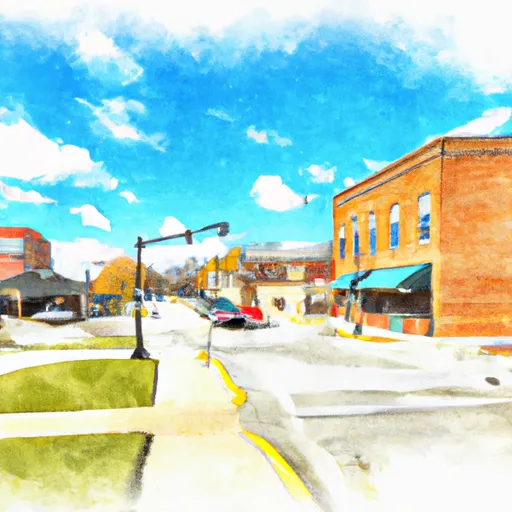-
 Snoflo Premium
Snoflo Premium
Get unlimited access to all our content
With no Ad interruptions! - Start Your Free Trial Login with existing account
Alto-Pass
Eden Index
Climate
8.1
•
Recreation
6.8
•
Community
•
Safeguard
5.6/10

Alto Pass is a small village located in Southern Illinois known for its beautiful countryside and outdoor recreational opportunities. The climate in Alto Pass is typical of the Midwest, with hot summers and cold winters. The region is rich in hydrology constituents, with several lakes and rivers in the area, including Cedar Lake and the Mississippi River. Outdoor enthusiasts can enjoy hiking and biking trails, fishing, boating, and hunting in the Shawnee National Forest, which surrounds Alto Pass. Other popular attractions include the Bald Knob Cross of Peace, a towering cross that offers stunning views of the surrounding area, and the Alto Pass Vineyards, where visitors can sample local wines and enjoy live music events.
What is the Eden Index?
The Snoflo Eden Index serves as a comprehensive rating system for regions, evaluating their desirability through a holistic assessment of climate health, outdoor recreation opportunities, and natural disaster risk, acknowledging the profound impact of these factors on livability and well-being.
Climate Health Indicator (CHI): 8.1
Alto-Pass receives approximately
1220mm of rain per year,
with humidity levels near 84%
and air temperatures averaging around
14°C.
Alto-Pass has a plant hardyness factor of
6, meaning
plants and agriculture in this region thrive during a short period during spring and early summer. Most
plants will die off during the colder winter months.
By considering the ideal temperature range, reliable water supplies, clean air, and stable seasonal rain or snowpacks, the Climate Health Indicator (CHI) underscores the significance of a healthy climate as the foundation for quality living.
A healthy climate is paramount for ensuring a high quality of life and livability in a region, fostering both physical well-being and environmental harmony. This can be characterized by ideal temperatures, reliable access to water supplies, clean air, and consistent seasonal rain or snowpacks.
Weather Forecast
Streamflow Conditions
Upper Mississippi-Meramec
Area Rivers
Upper Mississippi-Meramec
Snowpack Depths
Upper Mississippi-Meramec
Reservoir Storage Capacity
Upper Mississippi-Meramec
Groundwater Levels
Recreational Opportunity Index (ROI): 6.8
The Recreational Opportunity Index (ROI) recognizes the value of outdoor recreational options, such as parks, hiking trails, camping sites, and fishing spots, while acknowledging that climate plays a pivotal role in ensuring the comfort and consistency of these experiences.
Access to outdoor recreational opportunities, encompassing activities such as parks, hiking, camping, and fishing, is crucial for overall well-being, and the climate plays a pivotal role in enabling and enhancing these experiences, ensuring that individuals can engage in nature-based activities comfortably and consistently.
Camping Areas
| Campground | Campsites | Reservations | Toilets | Showers | Elevation |
|---|---|---|---|---|---|
| Flint Creek Waterpark | 156 | 246 ft | |||
| Moodys Landing | 7 | 135 ft | |||
| Big Biloxi Rec Area | 31 | 50 ft | |||
| Paul B Johnson State Park | None | 245 ft | |||
| McLeod Water Park | None | 22 ft | |||
| Lake Walker Military - Camp Shelby | None | 239 ft | |||
| Marathon Lake | 71 | 481 ft | |||
| Little Black Creek Waterpark | None | 296 ft | |||
| Big Creek Waterpark | None | 254 ft | |||
| Buccaneer State Park | 276 | 5 ft |
Nearby Fishing
Nearby Ski Areas
Catastrophe Safeguard Index (CSI):
The Catastrophe Safeguard Index (CSI) recognizes that natural disaster risk, encompassing floods, fires, hurricanes, and tornadoes, can drastically affect safety and the overall appeal of an area.
The level of natural disaster risk in a region significantly affects safety and the overall livability, with climate change amplifying these risks by potentially increasing the frequency and intensity of events like floods, fires, hurricanes, and tornadoes, thereby posing substantial challenges to community resilience and well-being.
Community Resilience Indicator (CRI):
The Community Resilience Indicator (CRI) recognizes that education, healthcare, and socioeconomics are crucial to the well-being of a region. The CRI acknowledges the profound impact of these elements on residents' overall quality of life. By evaluating educational resources, healthcare accessibility, and economic inclusivity, the index captures the essential aspects that contribute to a thriving community, fostering resident satisfaction, equity, and social cohesion.

